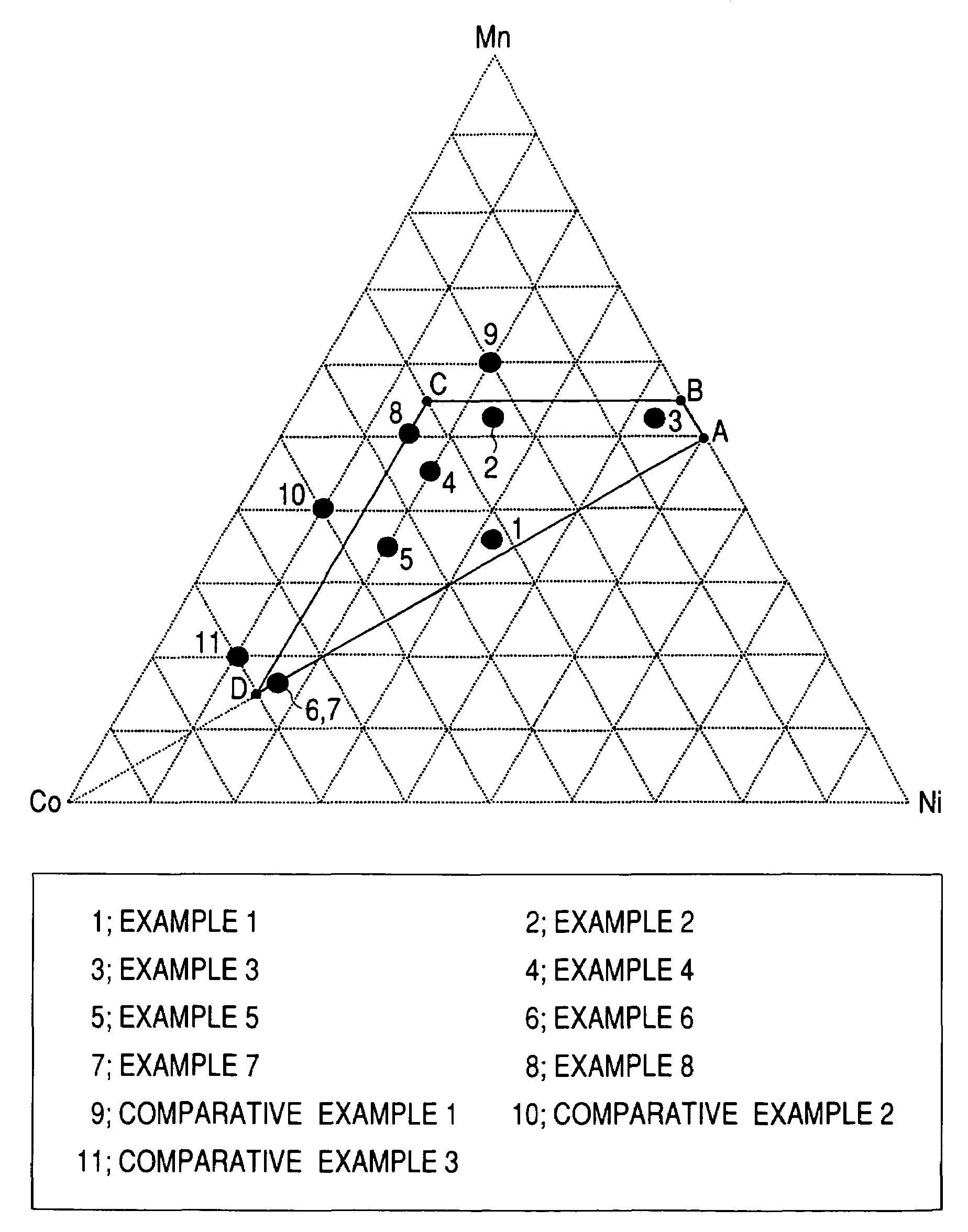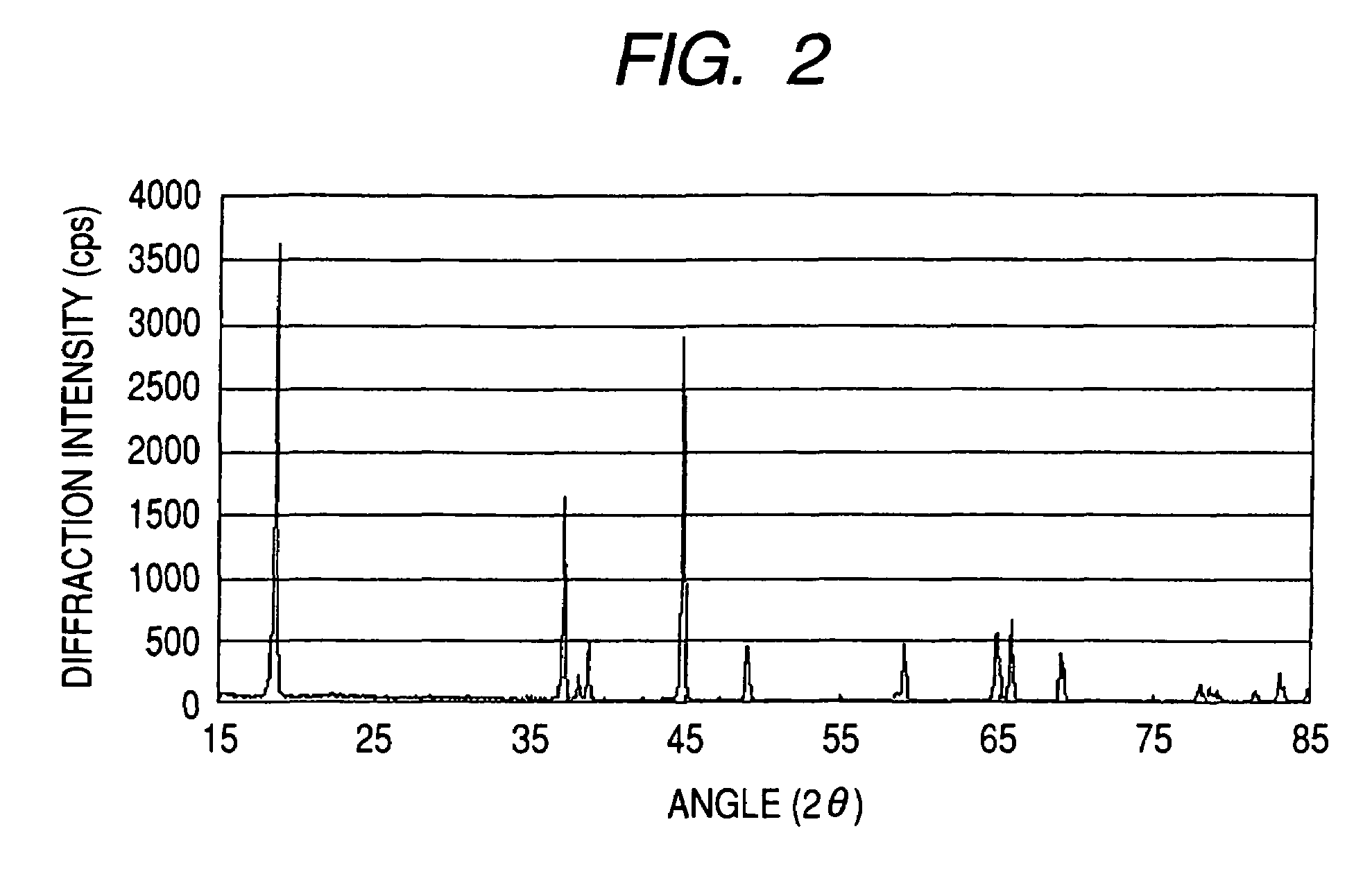Positive electrode active material for lithium secondary cell and lithium secondary cell
a lithium secondary battery and active material technology, applied in nickel compounds, digital output to print units, non-metal conductors, etc., can solve the problems of insufficient reversibility of lithium ion insertion/extraction reactions, light decrease in theoretical electrochemical capacity, etc., to achieve satisfactory high-rate charge/discharge cycle performance, excellent cycle performance, and high energy density
- Summary
- Abstract
- Description
- Claims
- Application Information
AI Technical Summary
Benefits of technology
Problems solved by technology
Method used
Image
Examples
example 1
[0156]Into a closed type reaction vessel was introduced 3 L (liters) of water. Thereto was added 32% aqueous sodium hydroxide solution in such an amount as to result in a pH of 11.6. The contents were stirred with a stirrer having a paddle type stirring blades at 1,200 rpm, and the temperature of the solution in the reaction vessel was kept at 50° C. with a heater. Furthermore, argon gas was passed through the solution to remove dissolved oxygen.
[0157]On the other hand, a starting-material solution was prepared. The starting-material solution to be used in this Example was obtained by mixing an aqueous manganese sulfate (MnSO4) solution with an aqueous nickel sulfate (NiSO4) solution, aqueous cobalt sulfate (CoSO4) solution, and aqueous hydrazine (NH2NH2) solution so as to result in a manganese concentration of 0.633 mol / L, nickel concentration of 0.563 mol / L, cobalt concentration of 0.563 mol / L, and hydrazine concentration of 0.0101 mol / L.
[0158]While the solution in the reaction ve...
example 2
[0160]An Mn—Ni—Co coprecipitated precursor was produced in the same manner as in Example 1, except that use was made of a starting-material solution obtained by mixing an aqueous manganese sulfate (MnSO4) solution with an aqueous nickel sulfate (NiSO4) solution, aqueous cobalt sulfate (CoSO4) solution, and aqueous hydrazine (NH2NH2) solution so as to result in a manganese concentration of 0.915 mol / L, nickel concentration of 0.422 mol / L, cobalt concentration of 0.422 mol / L, and hydrazine concentration of 0.0101 mol / L. Analysis by X-ray diffractometry revealed that the Mn—Ni—Co coprecipitated precursor mainly comprised a β-Ni(OH)2 type crystal structure.
[0161]The Mn—Ni—Co coprecipitated precursor obtained and a powder of lithium hydroxide monohydrate were weighed out so as to result in an Li / (Ni+Mn+Co) atomic ratio of 1.3. An Li—Mn—Ni—Co composite oxide was obtained therefrom in the same manner as in Example 1. As a result of analysis of the thus-obtained Li—Mn—Ni—Co composite oxide ...
example 3
[0162]An Mn—Ni—Co coprecipitated precursor was produced in the same manner as in Example 1, except that use was made of a starting-material solution obtained by mixing an aqueous manganese sulfate (MnSO4) solution with an aqueous nickel sulfate (NiSO4) solution, aqueous cobalt sulfate (CoSO4) solution, and aqueous hydrazine (NH2NH2) solution so as to result in a manganese concentration of 0.915 mol / L, nickel concentration of 0.756 mol / L, cobalt concentration of 0.088 mol / L, and hydrazine concentration of 0.0101 mol / L. Analysis by X-ray diffractometry revealed that the Mn—Ni—Co coprecipitated precursor mainly comprised a β-Ni(OH)2 type crystal structure.
[0163]The Mn—Ni—Co coprecipitated precursor obtained and a powder of lithium hydroxide monohydrate were weighed out so as to result in an Li / (Ni+Mn+Co) atomic ratio of 1.1. An Li—Mn—Ni—Co composite oxide was obtained therefrom in the same manner as in Example 1. As a result of analysis of the thus-obtained Li—Mn—Ni—Co composite oxide ...
PUM
 Login to View More
Login to View More Abstract
Description
Claims
Application Information
 Login to View More
Login to View More - R&D
- Intellectual Property
- Life Sciences
- Materials
- Tech Scout
- Unparalleled Data Quality
- Higher Quality Content
- 60% Fewer Hallucinations
Browse by: Latest US Patents, China's latest patents, Technical Efficacy Thesaurus, Application Domain, Technology Topic, Popular Technical Reports.
© 2025 PatSnap. All rights reserved.Legal|Privacy policy|Modern Slavery Act Transparency Statement|Sitemap|About US| Contact US: help@patsnap.com



